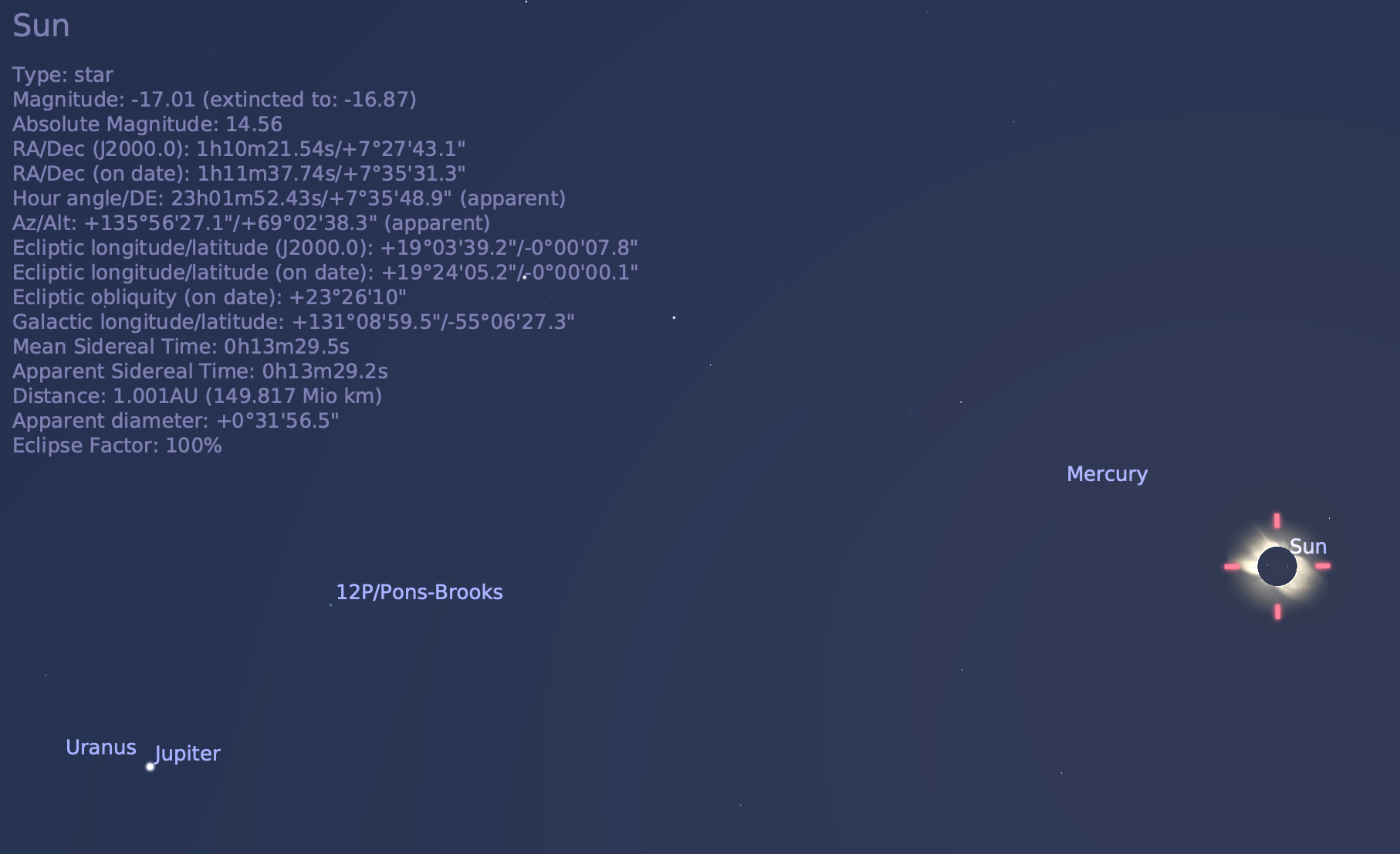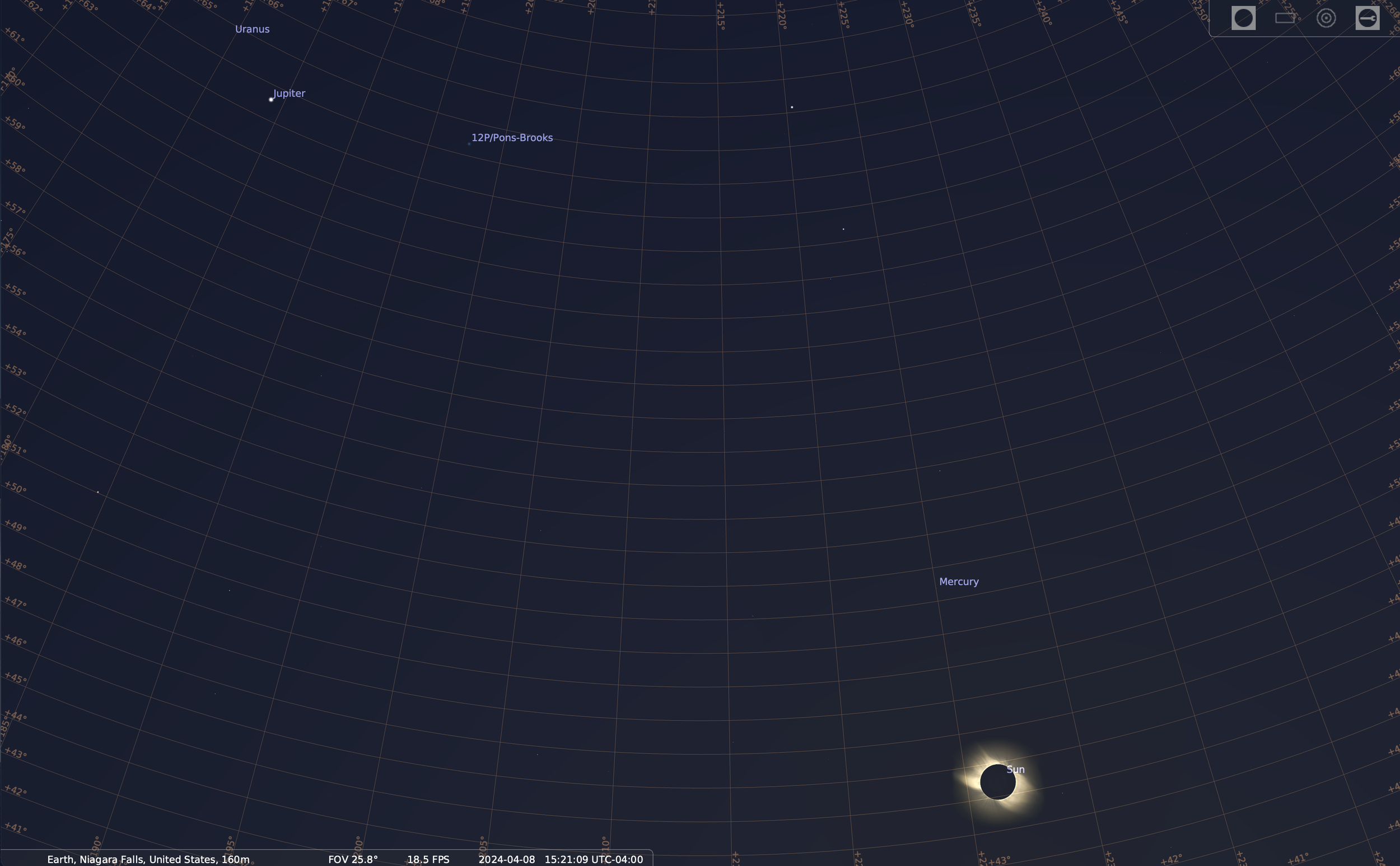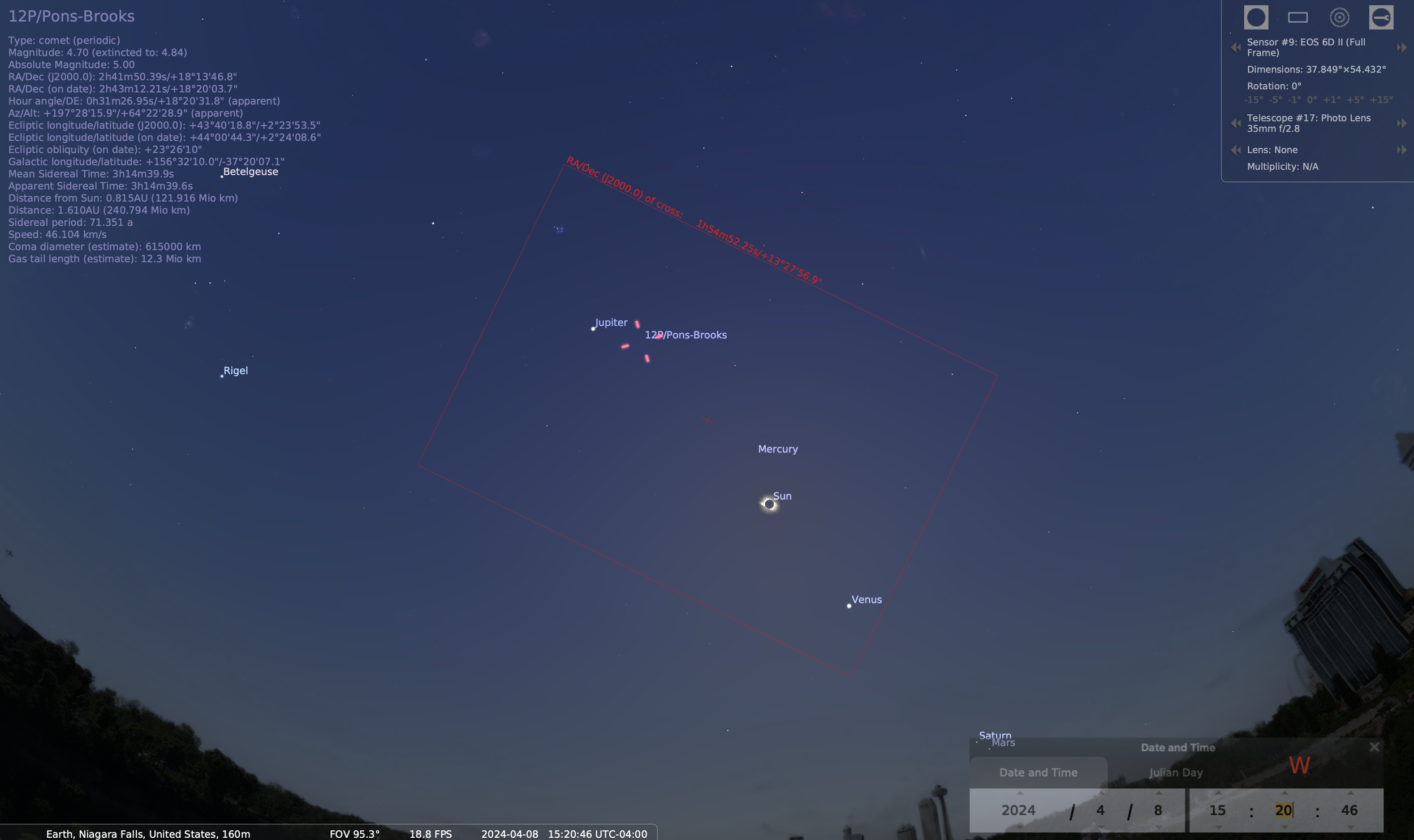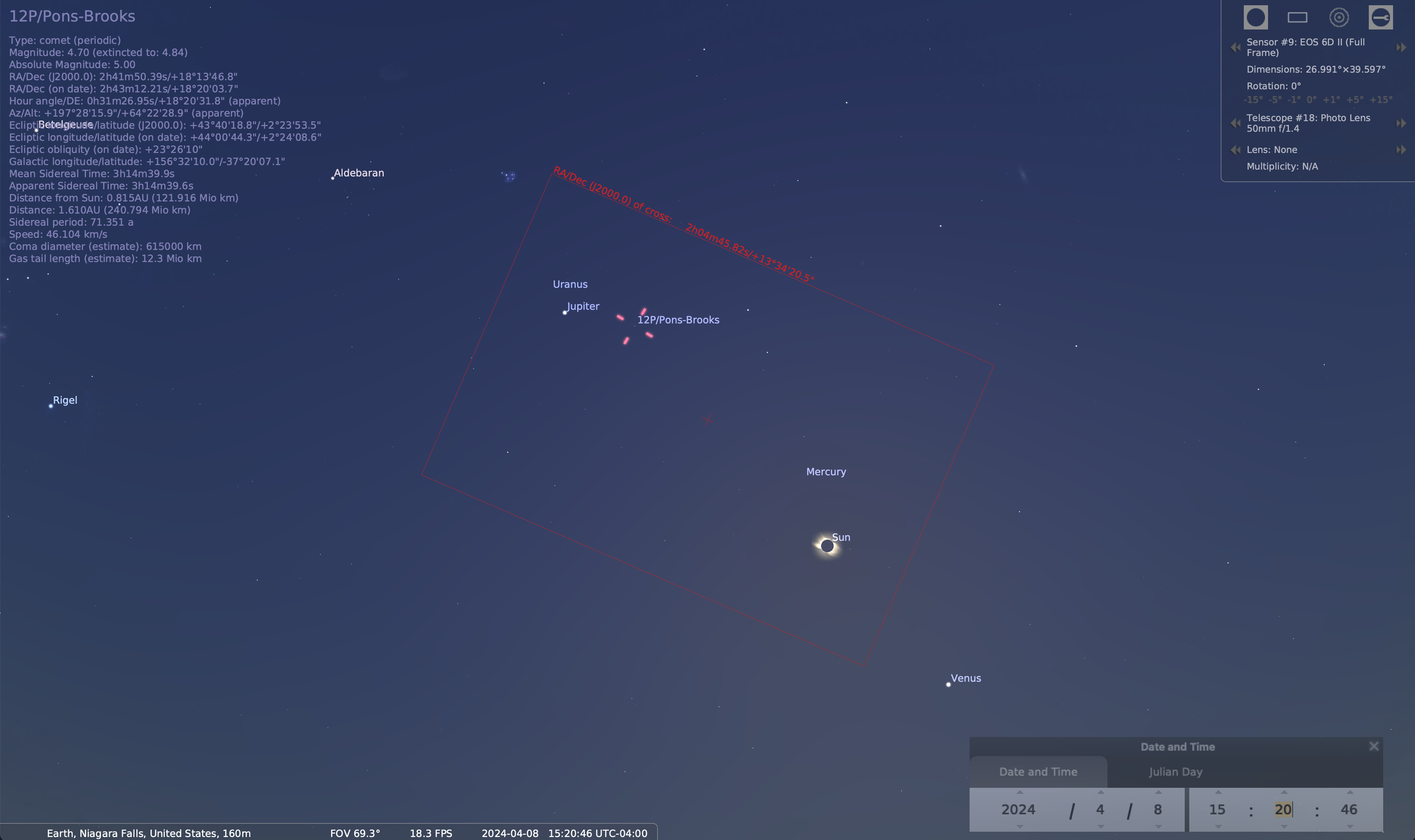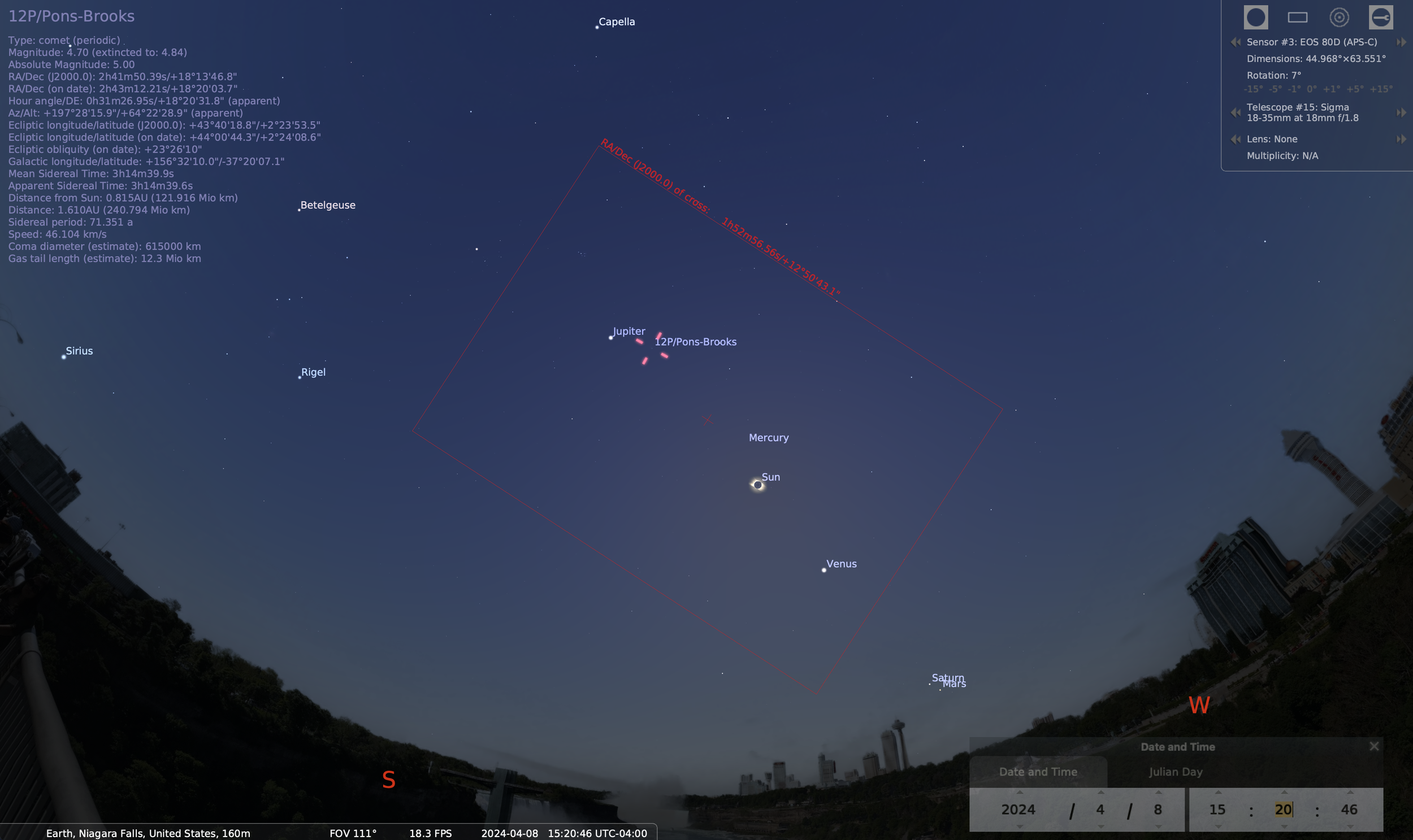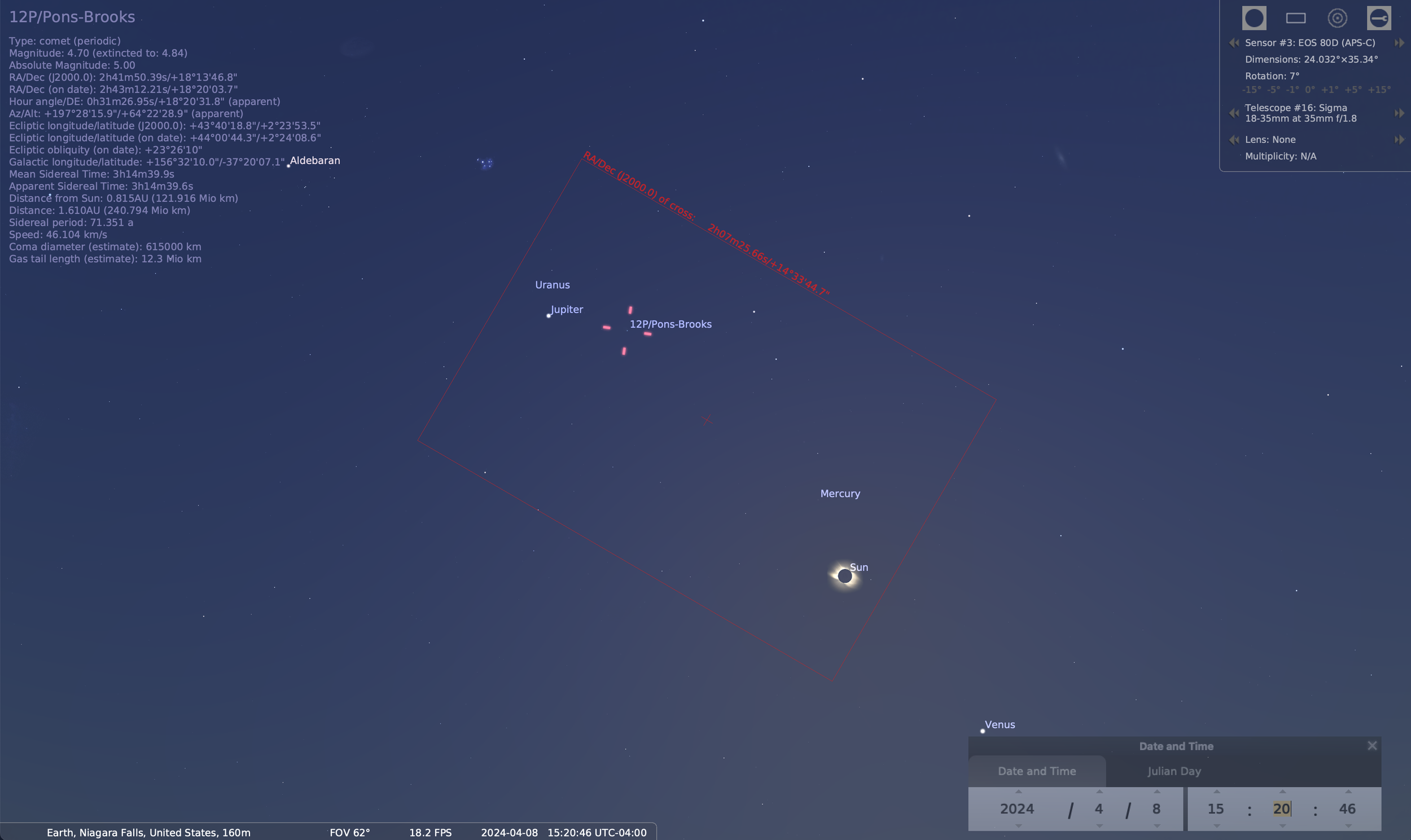Viewing and Photographing the Devil Comet During the 2024 Eclipse
An assessment of how possible it would be to see or photograph Comet 12P/Pons-Brooks -the so-called Devil Comet- during the 8 April 2024 eclipse, how you could do it, and why -in my opinion- you shouldn’t make it a priority.
Bottom Line Up Front:
Yes, the Comet 12P/Pons-Brooks -also known as the Devil Comet- will be visible during the 8 April 2024 eclipse, but will not likely be visible to the naked eye.
NO, the Devil Comet will NOT “block” or even “photobomb” the total eclipse, and will in fact be a considerable distance away from the sun and moon.
Viewing the Devil Comet during totality will only likely be possible with binoculars or a telescope, but this increases the possibility of eye damage and should not be your priority since comets are common but the next total eclipse in central North America will not be until the mid-2040s.
Photographing the Devil Comet and totality in the same image will be extremely difficult if possible at all.
Don’t be tempted by the Devil Comet and enjoy nature’s greatest spectacle -the total solar eclipse- without distraction!
What is Comet 12P/Pons-Brooks? Why is it Called the Devil Comet?
Starting with the basics, Comet 12P/Pons-Brooks is an approximately 10-mile-wide / 17-kilometer-wide comet which circles the sun about every 71 years. It will reach perihelion (be closest to the sun) on 21 April 2024 and be closest to earth on 2 June 2024. It is called the “Devil Comet” because recent images of it have shown its icy core being ejected in long strands on either side of the central mass. Some have likened it to the “Millennium Falcon” as well. Here’s an entry from NASA’s Astronomy Picture of the Day showing 12P and its devil horn effect.
Why Are Astronomers and Astrophotographers So Excited?
The possibility of a city-sized comet being visible so near to a totally eclipsed moon has both visual astronomers and astrophotographers giddy with the prospect of seeing or even capturing both 12P and the total eclipse at the same time. Also, given Comet 12P’s trajectory, it is difficult to normally see in the area of the eclipse as it is only above the horizon during the daytime when it can’t be seen.
How Bright Will the Devil Comet be During Totality?
To answer that, I need to take a moment to talk about apparent magnitude. Apparent magnitude is a scale used to indicate the brightness of objects as seen from earth. Somewhat confusingly, the higher the apparent magnitude, the less bright the object is. To help explain this further, here are the apparent magnitudes of the planets during totality on 8 April:
Venus: -3.89
Jupiter: -2.04
Mars: 1.17
Saturn: 1.13
Mercury: 5.15
Uranus: 5.82
You can see Venus will be the brightest of the planets and thus the easiest to see. Jupiter -another easy-to-spot planet- is the next brightest. This continues until you reach Uranus at 5.82. Even if you are a complete novice at astronomy, you’ve undoubtedly seen Venus and Jupiter in the night sky before, and the reason why is they are generally so much brighter than any of the other planets as you can see.
It is worth noting that each whole number increase does not represent a doubling of brightness. Rather, the difference in brightness is calculated using the following equation: 10^(.4x(the difference in brightness between the two objects)). I’m sure this is confusing mainly as a result of my inability to type mathematical font in website code, so let’s look quickly at Venus and Jupiter to see how much brighter Venus is.
The difference in apparent magnitude between Venus and Jupiter is 1.85 (that is, -3.89 - -2.04). We then multiple this figure by .4: 1.85x.4 = .74. We then raise 10 to the power of this number: 10^.74 = 5.5. So we now know Venus will appear to be about 5.5 times brighter than Jupiter on 8 April 2024.
(Why is this scale like this, with weird math and a counterintuitive backwards number systen? Who knows….)
It is also worth noting that -generally speaking- objects dimmer than 3 cannot be seen with the naked eye in an urban area, and objects dimmer than about 5 cannot be seen with the naked eye in the darkest places on earth. (Interesting side-note: in a really, really dark place, you can see Uranus without binoculars or a telescope but only if you view it from the corner of your eye so the light passes through more rods.)
So hopefully you’re now wondering: what is the apparent magnitude of 12P? This is where things get complicated.
You see, stars and planets are generally fixed -or, at least predictable- objects in the sky. Stars don’t change their distance to earth dramatically, nor does their luminosity change significantly (Betelgeuse being an exception, I suppose). Planets do change their “size” (that is, distance relative to earth), but they do so in very predictable ways and -since they only reflect light from the sun- we can determine very accurately their apparent magnitude based on the locations of the planet, sun, and earth.
Comets behave differently. While their paths of travel are pretty well understood, comets are always shedding material at different rates which affects not only how visible the comet’s core is but also how pronounced their tail is. Furthermore, the comet’s core (called a coma) will dramatically and somewhat unpredictably change shape as it gets closer to the sun.
That said, we can roughly estimate the apparent magnitude of 12P. And by we, I mean astronomers and other smart science-y people, certainly not myself. Anyway, they believe the peak apparent magnitude of 12P will be about 4.5.
Will the Devil Comet Be Visible to the Naked Eye During Totality?
Above, we clarified that a moderate confidence assessment of 12P’s apparent magnitude is about 4.5, and we also discussed how any celestial object with an apparent magnitude larger than 3 can only be seen in the darkest of night skies. As such, we can assume that 12P will just be visible to the human eye in a remote location, yes? Well, not exactly.
Here’s the problem: while a total eclipse will turn the whole sky dark for a few minutes in the middle of the day, the amount of light wrapping around the moon will still make it seem brighter than a moonless night in a remote location, or even a moonless night in an inner city.
Let’s break this down mathematically: the sun normally has an apparent magnitude of -26.75, give or take. During totality, the sun will still have an apparent magnitude of -17!
Using the nightmare fuel mathematical equation above, we can determine how much brighter the sun is normally than during totality: -26.75 - -17 = difference of magnitude of 9.75 -> 9.75x.4 = 3.9 -> 10^3.9 = 7943 times brighter. Inverting this figure, totality is .01% as bright as a normal sun. Great news, right?
Unfortunately not. Even .01% of the sun’s total light is still an incredible amount of light and is quite bright.
Let’s compare the magnitude of an eclipsed sun to the magnitude of a full moon, which is roughly -12.75:
-17 - -12.75 = 4.25 difference of magnitude -> 4.25x.4 = 1.7 -> 10^1.7 = 50.
To put this another way, totality is 50 times brighter than a full moon!
So, think back to what I said earlier about 12P being visible to the naked eye under only the most ideal of circumstances (moonless night in a remote area), then consider there will be a light source 50 times brighter than a full moon in the sky nearby, and I am skeptical 12P will even be visible to the naked eye during totality.
Now, you may well be able to see 12P with binoculars or a telescope, but I’ll explain a little later why I don’t think that’s a great idea.
How to Find the Devil Comet During Totality
If you absolutely must try to see Comet 12P during totality, the best way to do this quickly will be to make a line between the Pleiades star cluster, the sun, Venus, and the nearly overlapping Saturn / Mars. The Devil Comet will appear along this line just above Jupiter.
(It’s worth noting that even in this apparent magnitude-corrected image from Stellarium Comet 12P appears so faint compared to the planets and even some surrounding stars.)
Can You Photograph Comet 12P During Totality?
Unfortunately, I’ve seen several news reports as well as articles on (shudder) “scientific” websites leading readers to believe Comet 12P will appear right next to the sun and “photobomb” totality, or -most ridiculously- “block” the total eclipse. Seriously, look at this headline!
Well, you can see from the following images they’ve straight-up been misleading people. Here’s what it will look like at Niagara Falls, with azimuth and altitude degrees annotated:
And here it is in Mazatlan, Mexico:
The fact is no matter where you are viewing totality, the Devil Comet will be about 25 degrees in the sky away from the sun, which is a pretty considerable distance. This is the width of two or three outstretched fists across the sky.
So, if you must try to photograph Comet 12P and totality at the same time is to break out the wide-angle lenses.
One of my favorite features of Stellarium is that you can add camera lenses as telescopes and it will show you what your field of view may look like.
Here are four potential framings of the sun and Comet 12P. First up, a full frame camera with a 35mm lens:
Next, a full frame camera with a 50mm lens:
Next, a crop sensor camera with an 18mm lens:
Finally, a crop sensor camera with a 35mm lens:
So, it is possible to frame the Devil Comet quite nicely during totality, but there are some other things to be aware of if you are going to attempt to take a photo of this event.
First things first, you are going to need a very wide aperture lens because Comet 12P is so faint. To try this, you’re going to need a lens faster than f/2.0 to gather light as quickly as possible.
Second, you are 100% going to need this camera to be on a tripod for a long exposure. I’ll talk a little bit later about long exposure photography in this case is difficult in and of itself, but regardless I can guarantee you there is a 0% chance you’ll be able to hand-hold this shot successfully.
Third, you are going to have to account for the comparative difference in brightness across the image. Rough math, the eclipsed sun is going to appear 400 million times brighter than Comet 12P.
My last bit of advice for anyone trying this: make this a stand-alone set-up. In other words, take this shot on a camera you’re not already using for other phases of the eclipse so you don’t need to do a hasty lens change during totality. I’d also encourage you to have an easily removable solar cover on your lens so you can frame the shot during the later phases of the partial eclipse and easily transition into photographing during totality without having to worry about unscrewing a threaded lens filter.
So, is it possible to capture Comet 12P and totality in the same image? I’m honestly not certain, but I can guarantee that if it is possible it won’t be easy. I’ll talk more about why in a moment.
Can I Test My Camera Equipment Ahead of Time?
The unfortunate thing about being an eclipse photographer is we don’t get a whole lot of practice and it is very difficult to replicate totality for test-runs of our equipment.
In this particular case, my best advice would be to try and photograph the Jovian moon of Ganymede during a full moon with the same lens, camera, and tripod you plan to use for Comet 12P. Ganymede is Jupiter’s brightest moon and has an apparent brightness very similar to the Devil Comet (4.61). It also sits close to a brighter object (Jupiter, obviously) which will require quick changes to camera settings to get right. Finally, if you bring the camera down five or six stops you can roughly approximate the amount of light you’ll have on eclipse day (remember: a totally eclipsed sun is 50x brighter than a full moon and if you carry over settings from a moon test, your image will be massively blown out by the much brighter background light - a five stop reduction will simulate lighting an object 32x as bright, while a 6 stop reduction will simulate lighting from an object 64x as bright.)
If you can’t stick the landing during these tests, I’d regrettably say you have next to no chance doing this while the pressure is on during totality. Which brings me to my next topic.
Should I Attempt to View or Photograph Comet 12P During Totality?
It pains me to say so, but my answer for the vast majority of people is no.
Starting with the obvious: totality only lasts a few minutes and it should be the star of the show (pun very much intended). Would the comet be super cool to look at? Certainly, but comets come and go and it is worth reminding that this will be the last total eclipse in central North America until the mid-2040s! The only course of action I can endorse is to take up to five seconds (yes, just five seconds) to try and spot the comet with a pair of binoculars, and only try to do so if you can identify Pleiades and Jupiter quickly and therefore have a really good idea where the comet may be. And, please, only do so during totality and very carefully, as even briefly looking at an eclipsed sun with magnification can be dangerous to your eyes. If you aren’t 100% certain you can do these tasks, then simply enjoy totality! It is amazing by itself and -unless you travel- it may be the last time you see it for a very long time!
As for photographing the comet: would it be the ultimate astrophotography flex to be the guy or gal who snagged the photo of the Devil Comet framed next to the total eclipse, ensuring your place in the Instagram Hall of Fame? Sure, but -unless you are really, really good at this sort of thing- you’re trading a maybe 1-in-100 chance of getting it right for not paying attention to the greatest of nature’s spectacles.
So, why do I give such low odds? First things first, as we discussed this will be a very, very dim object being imaged in the same photography as a very, very bright object. Again, even while totally eclipse the sun will be 400 million times brighter than the Devil Comet (apparent magnitude -17 vs. 4.5.) This is a nightmare for metering. To put this into context, I have extrapolated and applied the results of this study to make the following comparison: the different in apparent magnitude between the Devil Comet and the sun at totality is roughly the same as the difference between a full moon (-12.75) and a candle lit about one mile / 1.6 kilometers away from where it is being observed (conservatively, 8.75).
Second, you have a very low chance of correctly guessing an exposure time. Under normal circumstances astrophotographers can use the Rule of 500 to determine the longest possible exposure time a photograph can be before stars start to streak. For those unfamiliar, when imaging stars you divide the size of your lens in millimeters into 500 and that is the longest exposure you can take in seconds (example: 18mm into 500 means you can take a 27.77 second photograph). But here’s the rub: you’ll have the sun, the moon, multiple planets, and a comet in the same frame - all these celestial objects move slightly faster than the rotation of the earth, meaning you have to throw the rule of 500 out the window. How much shorter does your exposure need to be to stop motion blur? Would 25 seconds be sufficient? 20? 15? 10? I honestly don’t know, and -since these objects are all moving in different directions relative to one another- I’m not sure anyone can easily answer that question. Suffice it to say there’s a reason so many comet photographs have blurry stars in the background!
The only way to overcome this problem is to take multiple exposures at varying exposure times. This creates an additional problem, however, as each adjustment in exposure time needs to be accompanied by an f-stop adjustment to keep your metering centered and prevent blow-out from an overly-bright sun. On top of all of this, your sensor is going to be roasting (even 1/7943th the amount of light from the sun is still dangerous to camera sensors!) so you’re going to need a cool down period between shots. I would recommend a cool-down period at least equal to the length of the photograph you just took.
So let’s plan out a hypothetical imaging session during totality using notional f-stops on an 18mm lens:
Image 1: 10 seconds at f/1.4
[10 second cool down]
Image 2: 15 seconds at f/1.7
[15 second cool down]
Image 3: 20 seconds at f/2.0
[20 second cool down]
Image 4: 25 seconds at f/2.4
This works out to 115 seconds.
Let’s assume you quickly check your series and you realize you’re overexposed due to the sun and want to bump it down a stop across all exposures. Add another 115 seconds for a second sequence, plus another 25 seconds for cool-down between the last image of series one and the first of series two.
Also, you’re going to want to add 10 seconds to frame the image correctly at the beginning of the series. That’s 265 seconds in total.
In the best-case situation in central Mexico, totality will last 270 seconds.
What does this mean? You’ll have to get extremely lucky to get this shot right and you’ll spend the entire period of totality working on it.
Is this worth it? To me, absolutely not.
The only circumstance where I can endorse trying this shot is if you have your camera on a reliable tracker and your camera settings are automatically controlled across the series by software. And, even then, I’m not convinced Comet 12P will be bright enough to image.
An alternative may be to stick to one safe exposure duration and adjust aperture settings incrementally, but -even still- the best you can hope for would be 12 or 13 images at 10 seconds and you will spend the entirety of totality making adjustments. In my opinion, this sounds like a horrible way to spend an eclipse.
One last thing to drive my point home. I want you to take a look at this absolutely amazing photograph of Comet 12P by Samit Saha (please give it a like!). This photograph was taken in late February 2024 during a nearly full moon using a 135mm lens at f/2.0 for 60 seconds at ISO 400. We can use this photograph to “simulate” what a photograph during totality may look like using a 50mm lens at f/1.4 (which you see in the above Stellarium simulations is the best setup for capturing the comet and totality in the same shot on a full-frame camera).
First things first, we need to adjust the size of this photograph for a 50mm lens, which has about a 38% field-of-view compared to a 135mm lens.
Second, we need to adjust the sky exposure downward 5.5 stops to account for the 50x brighter light from totality than from a full moon (the foreground will remain the same brightness since it will be bathed in 50x more light).
Lastly, we need to assume that increasing ISO can compensate for dropping from a 60-second exposure to a 10-second exposure (the maximum exposure for a 50mm lens under the rule of 500). Even factoring in the change of lenses from f/2.0 to f/1.4, the ISO will need to change from 400 to 1250, give or take.
Anyway, here is the final result:
Image derived from a copyrighted photograph by Samit Saha; produced under fair use for educational purposes.
Not too great of a result, I think you’ll agree. And I have no reason to think attempting such a photograph during totality will turn out any better.
So, in summary: I recommend you not be tempted by the Devil Comet and just enjoy totality!
P.S. - if I am wrong and you want me to eat crow, feel free to tag me in your Devil Comet-Totality photo on Instagram or Threads. And, trust me, I want nothing more for me to be wrong about this!
